Quick search
CTRL+K
Quick search
CTRL+K

Budapest is one of the grand capitals along the Danube River, and its magnificent history dates back to Roman times and the military outpost Aquincum. There are still remains of excavated facilities to be seen from the Roman era, and since then, one of the most beautiful cities in Central Europe has grown on both sides of the river.
The hilly Buda district stands opposite the flat Pest, and the two boroughs are located on either side of the Danube, which wind through the Hungarian capital. The city is extremely rich in monuments from all periods over the last 2,000 years, and combined with its very beautiful location it offers ample opportunity for many great sights and interesting activities.
The hot springs of the city are unique and some very popular attractions, which for many is one of the reasons for a trip to Budapest. In several of the city’s spas and pools, you can go into the warm water year-round and both outdoors and indoors. And an added benefits is the decoration and architectural style of many of the grand spas.
Budapest has of course everything else that belongs to a large European capital with a rich history. Here are a lot of beautiful churches, large institutional buildings, pedestrian streets, museums and much more. You can also make some nice day trips out of town, and town along the Danube are great choices with much to see.
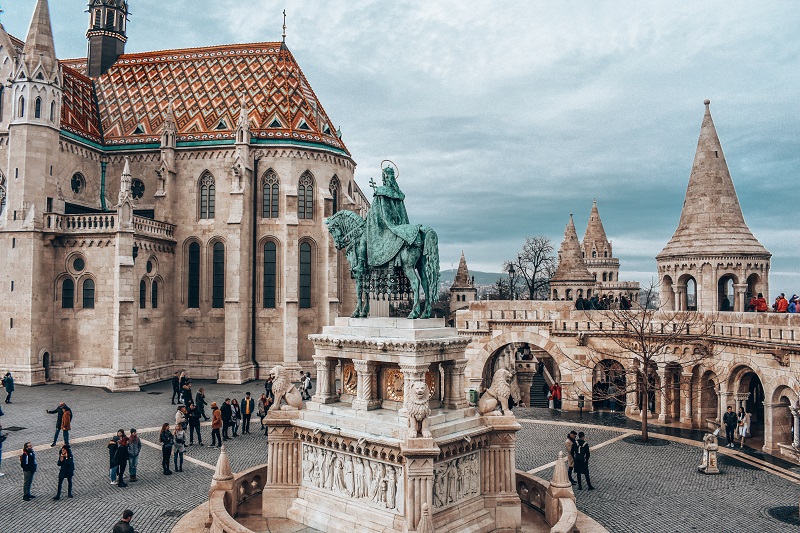
Halászbástya, also known as Fisherman’s Bastion, is a beautifully landscaped terrace with a large and six smaller towers. The facility was established in the years 1895-1902 on the site where fishermen in the Middle Ages patrolled for the city’s safety, and hence the name. The seven towers in total symbolize the seven tribes that settled in the Hungarian territory in the year 896.
From the bastion’s terrace on Buda’s ridge, there is a fantastic view of the Danube and the district of Pest, which lies on the flat land opposite Buda. On the southern part of the terrace you can see an equestrian statue of King Stefan I of Hungary. The statue was erected in 1906, and the reliefs on the pedestal show episodes from the king’s life. The place is popular with locals and tourists for the fine location and the view from here.
Budai Vár is Budapest’s old residential castle. Its history started in the middle of the 13th century, when King Béla IV had the first royal residence built. During the Middle Ages, the castle was greatly expanded over several rounds. The oldest part preserved to this day dates from the time of Prince István in the 14th century. When the Turkish Ottomans conquered Budapest in 1541, it was the beginning of a period of decay for the castle. For a time, the buildings were used as, among other things, barracks and storage.
In 1686 the castle buildings were severely destroyed during the siege and invasion of the city by allied Christian armies, and in 1715 the ruins were largely ordered removed. In the same year, the first part of the grandiose Baroque castle, which today stands beautifully above the city, was built. In 1748, Count Antal Grassalkovich took the initiative for an extension that was to be magnificent and stand as a symbol between the Hungarian nation and the ruling Habsburg family. The castle was then built in the years 1749-1769.
From 1791, the castle was made the official residence of the so-called palatine, who in the Kingdom of Hungary was the supreme representative of the Habsburgs, and the palatine was simultaneously the highest judicial authority in the country. From this title originates today the Palatine Crypt/Nádori Kripta, which is preserved under the castle. In 1849, Buda Castle almost burned to the ground during battles between Habsburg troops and revolutionary Hungarians in connection with the revolution that had started in 1848. Already the following year, reconstruction began, which was completed in 1856.
In 1867, the castle was an essential part of the setting for the coronation ceremony of Franz Joseph’s coronation as Hungarian king. It was an event that happened in connection with the Austro-Hungarian Compromise for greater consideration of the Hungarian nation in Austria-Hungary. In the period 1875-1912, the castle was once again expanded. It was to be as elegant as other large European royal residences, and the castle was then also called the Royal Palace/Királyi Palota.
After the dissolution of the Austro-Hungarian Empire, the royal palace became the residence of Miklós Horthy, who was officially regent of the Kingdom of Hungary in the period 1920-1944. In the latter part of World War II, the castle complex was once again destroyed, and a new reconstruction had to be initiated. The possible parts from the Middle Ages were excavated and preserved, while the neo-baroque castle was built in a highly modernized version, where many details were disregarded in the process. In 1966, the exterior was completed, while the interior was completed in the 1980s.
Today, you can enjoy the entire facility on a stroll to the large castle complex. You can see the castle from many places and from several angles, and it is of course a major attraction in Budapest. You can also see several museums in the fine buildings such as the Budapest History Museum/Budapesti Történeti Múzeum and the Hungarian National Gallery/Magyar Nemzeti Galéria.
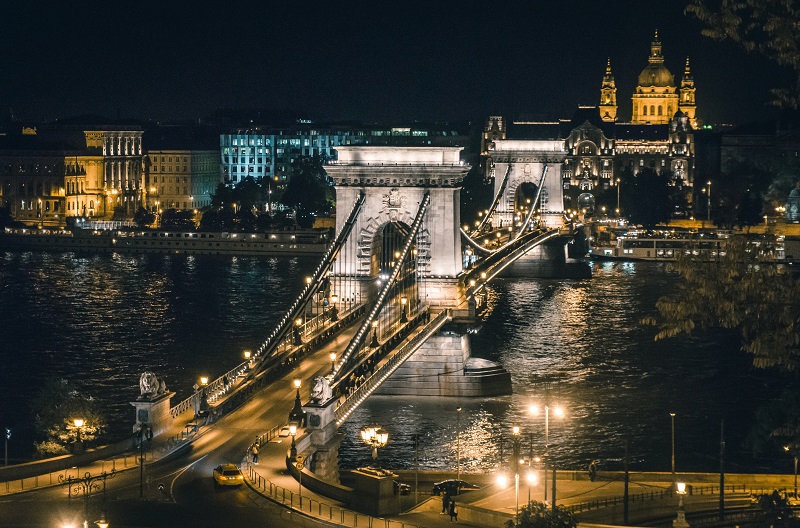
Széchenyi lánchíd is a bridge that stands as one of Budapest’s famous and most photographed landmarks. The bridge was built in 1849 as the first permanent bridge over the Danube, and thus also created a new and important connection between the districts of Buda and Pest.
The bridge is 375 meters long, and the span between the two beautiful pylons is 202 meters. The bridge was designed as early as 1839 and named in 1898 after the initiator, Count István Széchenyi. In the evening, the city is beautifully illuminated, and here the bridge and the entire course of the Danube through the Hungarian capital is an unforgettable sight.
Országház is the local hub for Hungary’s large Neo-Gothic parliament building, which was built mainly in Neo-Gothic style in the years 1885-1904. During the construction period, the building was inaugurated in 1896 to mark Hungary’s 1000th anniversary. The architect’s name was Imre Steindl, and he was inspired by London’s parliament building, Westminster Palace.
The Hungarian Parliament was built to house the country’s two chambers, the Lower House and the Upper House. Today, the Lower House is called the National Assembly/Országgyűlés, while the Upper House was closed in 1945. Imre Steindl won an architectural competition with his design, while two other submitted proposals were also built. They are both located opposite the Parliament on the square Kossuth Lajos tér.
The Országház is beautifully situated along the Danube as one of Budapest’s most well-known landmarks. The parliament building is 268 meters long and 115 meters wide. The dome is 96 meters high and contains the beautiful dome hall, where the well-known and magnificently designed main staircase is found. During Hungary’s communist era in the 20th century, the dome was adorned with a red star. It was taken down in 1990 after Mátyás Szűrös proclaimed the new Hungarian Republic from the balcony of the Parliament facing Kossuth Lajos tér on 23 October 1989.
The parliament is richly ornamented with, among other things, 242 sculptures on the facade, which represent Hungarian leaders and military personnel. Inside the parliament building, the Hungarian crown regalia are on display. They include the Stefanskronen/Szent Korona, which was produced in the 1000-1100s. You can also see the former floor of the Upper House, which is no longer used. It acts as an example of the corresponding and current hall for the National Assembly.
In the square in front of the building stands János Pásztor’s equestrian statue of Ferenc II Rákóczi, who in the years 1703-1711 led a rebellion against the ruling Habsburgs. You can also see several memorials, such as the monument to the Hungarian uprising in 1956. The square is named after Lajos Kossuth, who together with Sándor Petőfi became symbols of the Hungarian revolution under Austrian rule in 1848-1849.
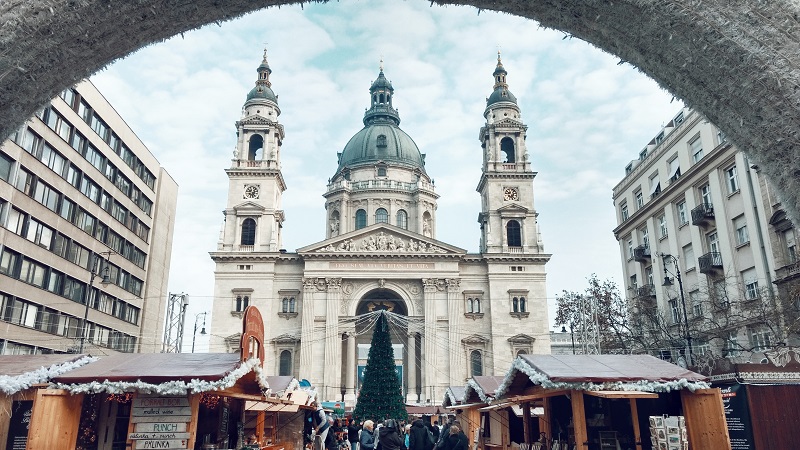
Szent István Basilica or Saint Stephen’s Basilica is Budapest’s Catholic cathedral. It has the status of co-cathedral together with the church Esztergomi bazilika in the city of Esztergom. The large large churches are thus the main churches in the archbishopric seat of Esztergom–Budapest.
Szent István Basilica was built in the years 1851-1905 as the most impressive church building in Hungary during this period. The style was Neo-Renaissance, and the majestic building was named after the country’s first Christian king, Saint Stephen, whose right hand and forearm are preserved in the church as relics.
The central dome reaches a height of 96 metres, making it one of the city’s tallest buildings. The 96 meters symbolize, just like the height of the parliament, the year 896, when Hungary was established. In the dome there is a viewing balcony, from which you can get a beautiful panoramic view of not least the central neighborhoods in the district of Pest.
The basilica is 55 meters wide and 87 meters long, it was completed in 1905 according to the design of the architect József Hild; however, it was Miklós Ybl who completed the construction after Hild’s death in 1867. Hild’s design was drawn in Neoclassicism, while Miklós Ybl adjusted the design in the direction of Neo-Renaissance.
When you enter St. Stephen’s Basilica, you are greeted by a lavishly decorated church room. At the main entrance you can see Károly Senyeis’ relief of Saint Stephen, and there are also mosaics by Bertalan Székely and Than Mór. You can also see the church’s beautiful dome and József Kauser’s altar and pulpit as a few of the basilica’s countless works of art.
M1 is line 1 of the Budapest metro network, and it is a special line. The subway is the second oldest in the world, and in age it is surpassed only by the London Underground. The line is now on UNESCO’s World Heritage List for its beautifully preserved condition, dating back to its opening in May 1896.
The track was built in the years 1894-1896, and it was built from the square Vörösmarty tér (which in 1896 was called Gizella tér) in the center and from there under the splendid street Andrássy út. to provide easy access to the large city park Városliget to the northeast. The metro was constructed as a covered excavation immediately below street level, and it was opened on 2 May 1896 by Emperor Franz Joseph I.
The original line had a length of 3.7 kilometers and is almost completely preserved with the original stations. There were nine stations underground and two above ground. Today, the outermost part towards the northeast has also been dug up, and the track has been extended to the station Mexikói út.
The original eleven stations were Gizella tér (now Vörösmarty tér), Deák Ferenc tér, Váczi körút (now Bajcsy-Zsiliszky út), Opera, Oktogon, Vörösmarty út, Körönd (now Kodály körönd), Bajza utca (defunct), Aréna út ( now Hősök tere), Állatkert (defunct) and Artézi furdő (now Széchenyi furdő, which is laid underground). At Deák Ferenc tér station, there is a small underground museum in the underground passage.
In the Városliget park, immediately north of Hősök tere square, you can see remains of the old railway line. Here there is a small and beautiful bridge in the middle of nowhere. Originally, this was where the subway came above ground, where it once ran under the bridge.
Hősök tere is one of Budapest’s most beautiful squares. It was largely laid out at the end of the boulevard Andrássy út and surrounded by fine buildings. The central element of the square is the Millennium Monument/Ezredéves emlékmű, which was erected from 1896 to celebrate the 1000th anniversary of the founding of Hungary. The monument was completed in 1929 and is now one of the city’s landmarks.
At the top of the monument’s 36 meter high column is a statue of the archangel Gabriel, and below you can see statues of the seven chieftains who are said to have led the Hungarian people here. In the middle you find Árpád, who is considered the country’s founder. Behind the column there is a colonnade on each side, and in the colonnade there are twice seven figures from Hungarian history.
On each side of the square you can see an impressive building. To the north is the Museum of Fine Arts/Szépművészeti Múzeum, which was built in neoclassicism 1900-1906. To the south you can see the Art Palace/Műcsarnok from 1896, which is also neoclassical.
Hősök tere forms a fixed point at the end of Andrássy út, and the square is also the entrance to the city park, Városliget, where you can visit the famous Széchenyi Bad/Széchenyi beach bath. Immediately within the park north of the square you can notice a small bridge over nowhere; it was built as a bridge over the metro line of the time on the site.
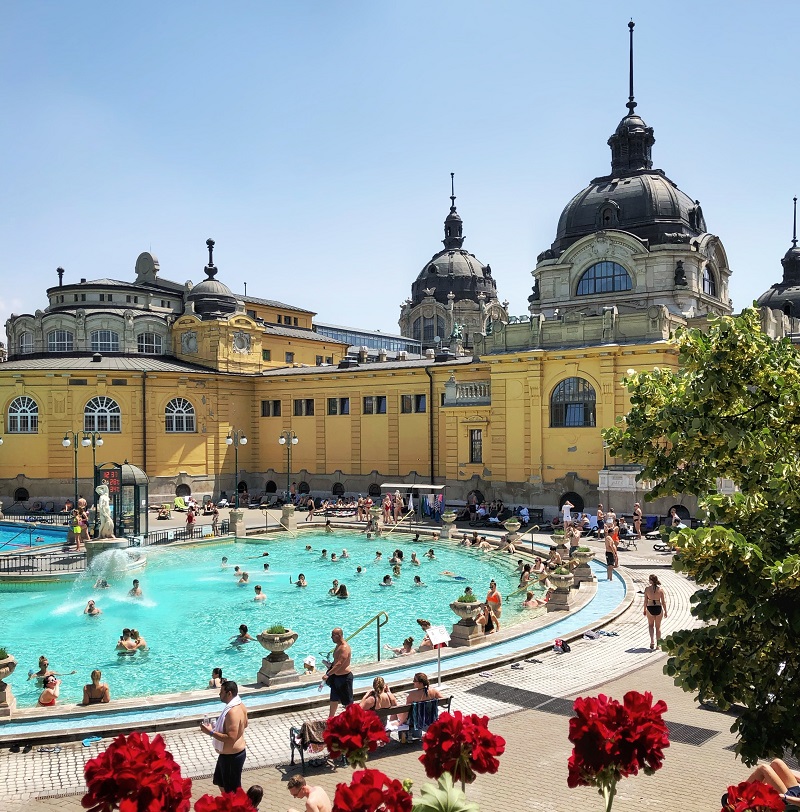
Széchenyi strandfürdő is an impressive and castle-like bathing facility, located northeast of the center of Budapest as one of the capital’s perhaps most well-known buildings. Széchenyi is Europe’s largest bath of its kind, and is considered by many to be Budapest’s best. The baths were built in the city park and opened in 1914 with the framing of buildings in imposing neo-baroque.
Of the city’s thermal baths, Széchenyi contains the warmest water, and in addition to indoor facilities such as steam and sulfur baths, there is also a large open-air hot bath in the center of the facility. The bath is very elegantly furnished as an experience in itself, and the water is so warm that the facility is also used in winter, which is a special experience that you can find here and in several other places in Budapest.
The Magyar Nemzeti Múzeum is Hungary’s national museum of archaeology, history and art, which was founded in 1802 when Count Ferenc Széchényi established a national library, which soon developed into a museum. Today, the museum offers fine exhibitions based on the country’s largest collections of art and various objects from Hungary’s history.
The large museum building in neoclassical style is worth seeing in itself. It was built for the purpose in the years 1837-1847 according to the drawings of the architect Mihály Pollack. The building was decorated with works by several artists, and there is, for example, a famous allegorical statue of Hungary holding a shield with the Hungarian coat of arms.
There are such rich collections at the museum that you can spend several days here. It can be a good idea to choose parts of the exhibitions or special themes or effects that you would like to see. Among the many beautiful things here are the Hungarian crown regalia from the 12th century, Roman mosaics as well as countless objects from the 11th and 19th centuries, which illuminate the development over the centuries in an interesting way.
Parisi udvar udvar or Pariserarkaden is a classy shopping arcade that was built in an eclectic style with elements of, for example, Gothic and Moorish style in the early 1900s. Its name comes from the name of the street next to the building, which is named after the French capital.
There was a house from 1817 on the site, which had fallen into disrepair at the end of the 19th century. After demolition, the current building was erected 1909-1913, and from the start it was equipped with shops and apartments, which were finely decorated. The house was declared a national monument in 1976 and therefore both worth seeing and preserving.
A trip to Parisi udvar is a trip to the beginning of the 20th century architecture and shopping centers, which here at one of Budapest’s most prestigious addresses of the time was extra fine. Beneath the period cast iron and the large glass dome, there are a wealth of fine architectural details to look at, and you can enjoy it all from the café and restaurant located here.
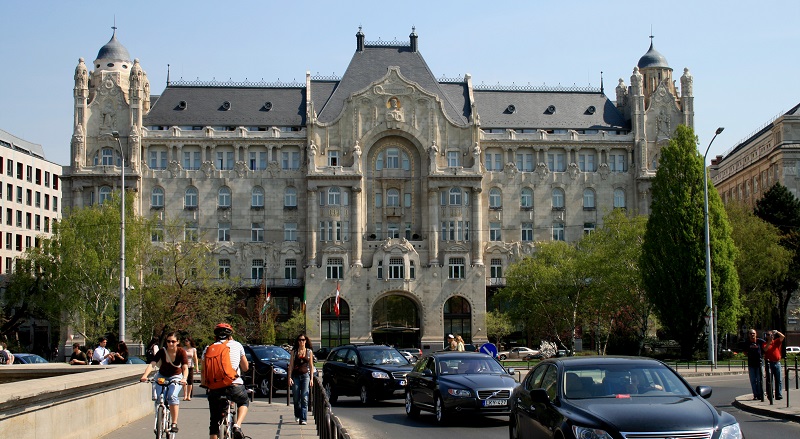
Gresham Palota is a large mansion located along the Danube in a fine location next to the beautiful chain bridge Széchenyi lánchíd. The mansion was completed in 1907, and it is today one of Budapest’s most significant buildings from that time. The large mansion is among the city’s finest in the Art Nouveau style of the time.
Gresham Palæ was built as the foreign head office of the English insurance company Gresham Life Assurance Company. In the decades after the Second World War it was furnished with residences, while today it is furnished as an upscale hotel. On a visit to the ground floor, visitors can get an insight into the exciting architecture.
Sándor palota is the name of the building that is the official residence of the Hungarian president and at the same time the office of the same office. The mansion has had this status since 2003. The history of the house goes back to the construction years 1803-1806, when Count Vincent Sándor had it built and it was named after him. It was later acquired by Archduke Albrecht, who was the Imperial Governor of Hungary, and he lived here until the failed revolution in Hungary in 1848.
The building was then rented and used as government offices. The most famous tenant was the Prime Minister Gyula Andrassy, who rented the place from 1867 on behalf of the government. Later, Andrassy bought the property, which he had renovated. On the ground floor there were government offices, while he furnished a residence on the first floor, and a total of nineteen prime ministers eventually lived here. In 1941, Prime Minister Pál Teleki committed suicide here as a consequence of Germany’s invasion of the country. Later in the war, the mansion was destroyed during an Allied bombing raid.
The mansion was continuously renovated after the system change in 1989, after having lain in ruins since the end of the Second World War. The walls were secured and a roof was put on, and in 2002 the restoration was complete.
The elegantly decorated mansion is open to the public on special occasions, and here you can admire the beautiful interior, which has been finely recreated from the furnishings of the past, on which the successive prime ministers each left their mark.
Budavári Sikló is an interesting and practical means of transport that connects the banks of the Danube River with the castle mound in Buda and thereby the majestic Buda Castle. The means of transport is a charming funicular that was built on a private initiative in 1870. 50 years later, the 95-metre-long track was taken over by the city government.
On a trip with Budavári Sikló, you climb a height difference of 51 metres, and along the way the maximum climb is 62%. On the trip, you come under two footbridges, from which there is a nice view of the small track. The bridges were built for the opening in 1870, but they were demolished in 1900 to be constructed again in 1983.
Incidentally, the place at the Széchenyi Lanchid suspension bridge and at the starting point of the funicular is the place where all kilometer indications in Hungary are measured from. At the top of the tour in the square Szent György tér, you can see the fine Habsburg staircase, which was built as a monumental entrance to the castle grounds in the early 1900s.
Budapesti Történeti Múzeum is a museum housed in the southern wing of Buda Castle. At the museum you can learn more about the history of Budapest, which is depicted in the exhibitions. Among other things, you can see various models of the city’s development and a large number of finds and objects from the Middle Ages, such as Gothic sculptures from the old castle.
It is also interesting to take a closer look at the development of the districts of Buda, Óbuda and Pest, which were independent cities until 1873. You can also enjoy the experience of the castle building on the tour through the museum, where you can see the beautiful halls that were recreated 1958-1962 after previous destructions. It is also on this site that the remains of Budapest’s medieval palace are located.
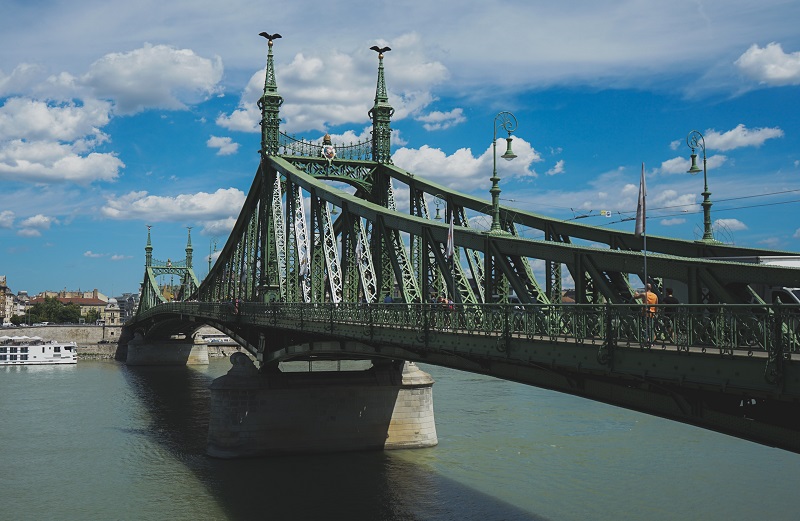
Szabadság bridge is one of the most striking of the many bridges that span the Danube and thereby connect the districts of Buda and Pest in the Hungarian capital. The bridge was constructed 1894-1896 and was completed on the 1000th anniversary of the Hungarians’ arrival in the area. It was previously named after Emperor Franz Joseph I, who at the inauguration himself put the last rivet in and thus completed the building.
It was János Feketeházy who designed the bridge, which is 336 meters long and 20 meters wide. The design, despite a different type of construction, imitated a chain bridge that was modern at the time. Szabadság híd got two pylons, and on each of them there are two spiers crowned with the bird Turul, which originates from Hungarian mythology.
Gellért hegy is a 235 meter high mountain from which you can enjoy some of the most beautiful views of Budapest and the river Danube. The mountain is named after Bishop Gellért, who preached the messages of Christianity in Hungary. On top of the mountain is a citadel and terraces that were built by the Austrians in 1848-1849.
The northern side of the mountain was home to wine production in the 18th century. The neighborhood is called Tabán, which later and until the 1930s was densely built up with some of the city’s worst housing. Today it has been developed as a lovely park. All in all, Gellért hegy is almost like a large green area with many hiking trails quite close to the center of Budapest, like a true oasis.
Magyar Állami Operaház is the Hungarian State Opera, which was built in Budapest 1875-1884 according to Miklós Ybl’s designs. The very beautiful building was financed by both the Austro-Hungarian Emperor Franz Joseph I and the city of Budapest, and it was built along the splendid Andrássy út.
The opera house is considered one of Miklós Ybl’s main works. It was designed in the Neo-Renaissance with elements from the Baroque, and the building was particularly richly ornamented. Inside, the foyer, the main staircase and the large stage with the mighty royal gallery are particularly interesting to note. And if you have the opportunity to attend a performance, you can enjoy the house’s acoustics, which are among the best in Europe.
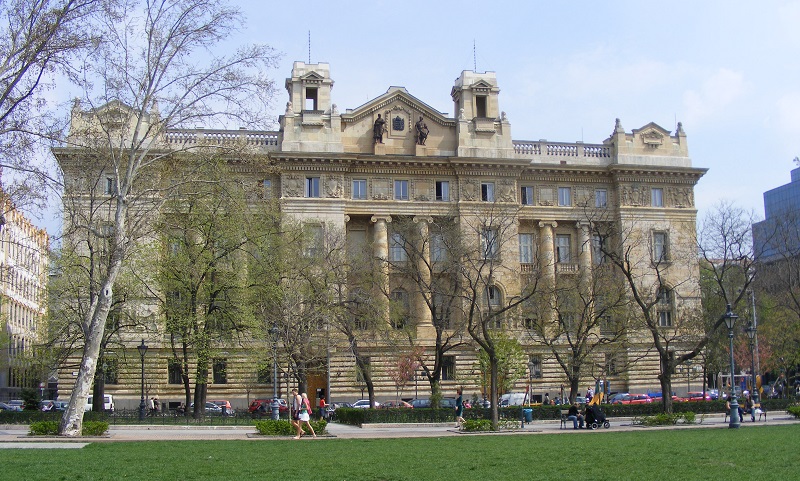
Szabadság tér is one of Budapest’s large landscaped squares, and you immediately see the open and green spaces here. In the center you can see the monument for the Soviet liberation of Budapest in World War II. It consists of an obelisk with a red star at the top, and it was erected in memory of the fallen Soviet soldiers in the battles for the city.
Around the square there are a number of imposing buildings. Among the interesting structures is the former headquarters of the Hungarian Television, Magyar Televízió (Szabadság tér 12), which runs along the entire western side of the square. Before World War II, the building housed a stock exchange. Opposite the television building is the National Bank of Hungary/Magyar Nemzeti Bank (Szabadság tér 8-9) and the US Embassy/Amerikai Nagykävség (Szabadság tér 12).
Váci utca is Budapest’s fine street with cafes and shops. The houses along the street mainly date from the 1800s and early 1900s, and a stroll here is, among other things, a wonderful experience because you can notice the many beautiful details on the buildings. The name of the street comes from the Vácz Gate/Váczi Kapu, which was located here and formed the northern entrance to the city of Pest.
To the north, the street starts from the square Vörösmarty tér, on which stands a statue of the poet Mihály Vörösmarty. The square is also home to the well-known Gerbeaud Café (Vörösmarty tér 7) and the building for the distinguished historic department store Luksus (Vörösmarty tér 3).
At the northern beginning of Váci utca is the Bank Palace/Bank Palota (Deák Ferenc utca 5), which was built as a bank building 1911-1915. In there, the city’s stock exchange is located here. Street number 9 is the place where the composer Franz Liszt played in 1823 as an 11-year-old in the banquet hall. However, the current building dates from 1840 and houses, among other things, the theater Pest Teater and the flower shop Philanthia, which opened in 1905. The interior of the shop is the original in beautiful art nouveau.
The house with number 11 is the architect Ödön Lechner’s house from 1888-1890, which he built for the furniture manufacturer Jakab Thonet, after whom it is now named. The house is beautifully decorated and known for the use of the so-called Zsolnay tiles.
On the southern part of Váci utca is the elegant Church of St. Michael/Szent Mihály templom, which was built in Baroque 1747-1749. A little further to the south is the Serbian Orthodox Church/szerb ortodox templom. Note that it is set back behind other houses. To the south, Váci utca ends at Fővám tér square.
Nagycsarnok is the Hungarian name for the Great Market Hall, which is considered by many to be Budapest’s most beautiful market. It is also the city’s largest indoor market hall, and the first plans for one were proposed in the 1860s. It took a few years before it was decided to build the market on the square Fővám tér, where there was a salt warehouse.
The hall was designed and built by the Hungarian architect Samu Peczs, and Nagycsarnok was opened in 1897. Originally, a canal went here from the nearby river Danube. In this way, goods could be shipped directly to the market. Today, the beautiful hall stands in all its grandeur with characteristic Zsolnay tiles from Pécs on the roof.
New York Kávéház is a place where you can experience the elegant Budapest around the year 1900. This can be done at the New York Café, which is one of the city’s many beautiful cafés. The café is located in the luxury hotel New York Palace and opened in 1894 as function rooms for the upper class. Today, the old premises are completely as new from the old days with all the decoration that belonged to the late 1800s.
The beautiful building was built by the New York Insurance Company. The primary architect was Alajos Hauszmann, and with the help of Flóris Korb and Kálmán Giergl, he created the richly decorated building with the characteristic tower and the many details on the facade. The rest of the New York Palace’s decor is also classy, and the hotel is in conjunction with the well-known café.
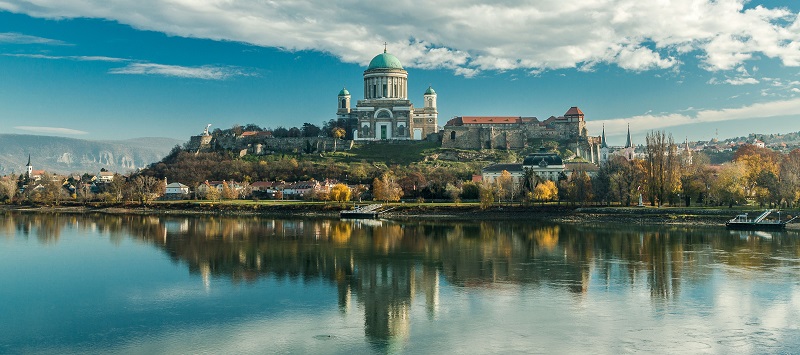
Esztergom is a city that has over time played a large role in Hungarian history. It was here that the country’s first Christian king was crowned. It happened in the year 1000, and the city was the capital of Hungary for the following centuries, until King Bela IV moved the capital to Buda in 1256, which is one of the independent cities that were merged into the present Budapest.
Esztergom is one of Hungary’s religious centers, as it, together with Saint Stephen’s Basilica in Budapest, is the seat of the country’s archbishop and thus a main seat of the Roman Catholic Church. Esztergom Cathedral/Esztergomi Bazilika (Szent István tér) is also Hungary’s largest church building. It was built 1822-1869 with dimensions of 118×48 meters as a base, and the dome reaches a height of 102 meters.
The interior height of the cathedral is 71.5 metres, and the church has room for 8,000 people, and there are several things to see in the beautiful church space. The approximately 13×6 meter altarpiece was painted on a piece of canvas by Michelangelo Grigoletto. From the Renaissance you can see the chapel of Tamás Bákocz, built in 1506-1507. Several former archbishops are buried in the crypt.
In addition to the cathedral, there are many beautiful buildings in Esztergom, whose old town is definitely worth a stroll. Here you can see, among other things, the Franciscan church Szent Anna-templom, the Christian Museum/Keresztény Múzeum and the bridge Mária Valéria híd, which leads to Slovakia on the opposite bank of the Danube.
János-hegy is the highest mountain in Budapest with its 528 meters. It is located west of the center and thus on the Buda side of the Hungarian capital. It is an area that is wooded and quite hilly.
The trip to Budapest’s highest point can be made using the fun ride on the Zugligeti Libegő chairlift. Like another ski lift, you are transported up the hill through nature, and from here there is a short hike to the 23.5 meter high observation tower Erzsébet Kilátó (Janoshegyi út), which was built in beautiful decorated style 1908-1910.
From the top there is a fabulous view of the area. You can enjoy it, just as you can enjoy nature on the mountain. You can also go up and around the hill with the Children’s Railway/Széchenyi-hegyi Gyermekvasút (Szilágyi Erzsébet fasor), which was built as an 11.2 kilometer long narrow-gauge railway as a kind of original copy of the Hungarian railways.
Aquincum is a Roman city founded in AD 89 and it was the capital of the Roman province of Pannonia Inferiore. At its peak, the city had a population of around 60,000. The major excavations of the historic city began at the behest of Queen Maria Theresia in the 18th century, and today it is quite a special experience to walk around the Roman streets and view the old city’s facilities.
In the area you can see, among other things, the ruins of the public baths, which were also used as a meeting place by the Romans, as well as the market hall Marcellum. You can also see examples of the Romans’ central heating system and sewage system. The most important finds are kept in the recreated Roman villa, which is centrally located in the facility as a museum.
Outside the museum area itself in this northernmost of Budapest’s three cities, you can see the ruins of the large amphitheater, Aquincumi katanai amfiteátrum, which was built around the year 150. Here there was room for 14,000 spectators. All around Budapest there are various ruins and remains from the Roman era, and these can be seen with advantage from an understanding of the time from Aquincum.
Szentendre is a very pleasant town, where there are buildings from the Middle Ages and the 18th century, a number of museums and, on the whole, many facilities for tourists who come here not least by train or ship from Budapest.
Art is the focus in Szentendre, which since the beginning of the 20th century has attracted many performing artists with the town’s beautiful location and vibrant environment. Therefore, today you can visit a large number of galleries and art museums. They can be found in the city’s cozy streets in the center.
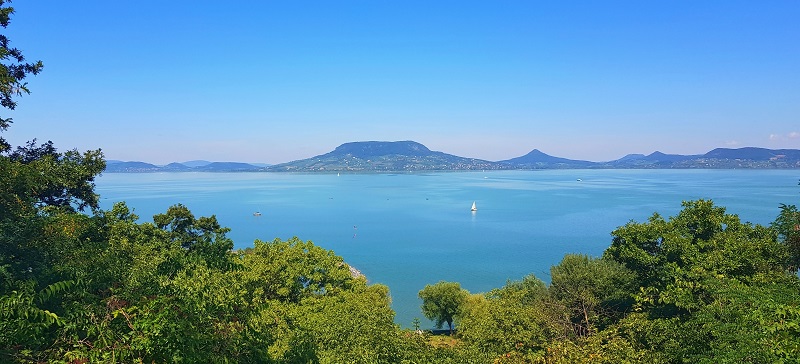
Balaton is the largest lake in both Hungary and Central Europe, and it is also called the Hungarian Sea with all that goes with bathing opportunities, water sports and experiences along the coast. In the summer, the lake’s water is often pleasantly warm, so the place is a very nice alternative to, for example, a trip to the beaches of the Mediterranean.
Balaton is 592 km² in surface, and it is 77 kilometers long and up to 14 kilometers wide. Its greatest depth is a good 12 meters. The size thereby emphasizes that the Hungarians themselves almost see the lake as a sea. Around Balaton are many lovely places where you can settle down for an entire holiday or take as an excursion destination. Some of the most popular are Siófok, Balatonfüred and Tihany.
Siófok is Balaton’s largest holiday area, and in the summer a multitude of tourists come here to enjoy the lovely beaches and the many activities and entertainment the town has to offer. Siófok is also a popular excursion destination from, for example, the capital Budapest, as it is one of the fastest cities to reach by, for example, the train.
Among Siófok’s sights is the modern Lutheran church, Evangélikus Templom, which may look like a cross between a teepee and a totem pole (Uj-piac tér). The centrally located water tower Víztorony (Fö tér) is the city’s landmark and one of the historic buildings, and opposite it is a fine Catholic church (u. Fö). Among the many beautiful facilities in the city is the park with, among other things, a music pavilion. It is located at Siófok’s castle-like railway station.
Balatonfüred is the largest holiday town on the north coast of Balaton. The town was the first resort to be built here, and the flow of tourists started in the 18th century. From the 19th century, the place attracted a number of artists and other well-known citizens who wanted to enjoy Balatonfüred’s sanatorium, which made use of the area’s mineral springs.
From the 1700s and 1800s, you can see a number of buildings that make the city’s atmosphere particularly rich and cozy. This applies, among other things, to the Store Kro/Nagyvendéglő (Blaha Lujza utca), which is now a hotel, and the neoclassical round church, Körtemplom (Blaha Lujza utca), which was built in the 1840s.
Tihany is a town located on the peninsula of the same name, and it is one of the pearls of Balaton. The town is situated above the lake and offers one of the most beautiful views over the water. At the top of Tihany is the city’s double-towered monastery church Tihanyi Apátság (I. András tér), which is one of Hungary’s most elegant baroque buildings. The church was built 1740-1754, and it is not least known for the beautiful woodcarving works from the 18th century and the frescoes from the 19th century.
A monastery church has been located on the same site since 1055. The founding document from this time contains the earliest written Hungarian words in existence. However, the document is not stored in Tihany. Next to the monastery church is a museum for the monastery.
Örs vezér tere 25
arkadbudapest.hu
Keleti Palyaudvar
arenaplaza.hu
Szilágyi Erzsébet Phasor 121
budagyongye.com
Nagytétényi u. 37-45
campona.hu
Rákóczi F. u. 154-170
csepelplaza.net
Bécsi u. 154
eurocenter-obuda.hu
Üllői u. 201
europark.hu
Lövöház utca 2
mammut.hu
Alkotás u. 53
mompark.hu
Szentmihályi 131
poluscenter.hu
Gábor Áron utca 74
rozsakert.hu
Nyugati tér 1-2
skala.hu
Váci, Nagy körút, Andrássy out
Állat-és Növénykert
Állatkerti krt. 6-12
zoobudapest.com
Széchenyi-hegyi Gyermekvasút
Hegyhát út,
gyermekvasut.com
Millennium Földalatti Vasút Museum
Deák Ferenc tere
bkv.hu/angol/muzeum
Vasuttortenetipark
Tatai 95
vasuttortenetipark.hu
Magyar Természettudományi Múzeum
Ludovika tér 2-6
nhmus.hu
Vidámpark
Állatkerti körút 14-16
vidampark.hu
The central location of Rome’s Aquincum Budapest on the Carpathian plain has for thousands of years brought various peoples to it, including Celts, Romans, Huns, Mongols and Germans.
The first settlement stood the Celts for about the year 0, and in the following centuries the Romans came to the area. They established Aquincum in present-day Óbuda, and as a fortified military post it became the capital of the Lower Pannonia region in 106.
Later the Magyars (Hungarians) arrived from western Siberia. They settled in the area and thus became the start of what later became Hungary. The Magyars were a horsemen, and it took time before they settled down and founded real cities.
After being defeated by the Germans in 955 in the Hungarian territory, and with the coronation of Stefan (Istvan) as the country’s first king in 1000, the country Hungary was founded.
The country’s first 250 years were affected by many disputes over the throne, weakening the country which lost territories to neighboring countries. To stop this development, the castle of Buda was built in 1247-1265 under Béla IV, and at the same time Pest became a city with royal privileges.
The new measures strengthened the cities of the Danube, which experienced a boom. The royal palace was expanded, a university in Óbuda was founded, and the first bridge over the Danube was built. The times of the rise came after the reign of Matthias Corvinus (1458-1490), under which Budapest had become one of Europe’s leading cities and the absolute capital of Hungary.
In 1526, Budapest was attacked by the Turks, who destroyed parts of the city before re-entering the city in 1541. It was a time when Budapest and Hungary’s period of independence and relative prosperity had ended.
The country’s own resistance and the aid from Austria sent the Turks to flight in 1686, after which Hungary became a province in Austria’s Habsburg Empire.
It was the start of Budapest’s great growth, both financially and culturally. Buda became German-speaking under the name Ofen, and in the late 18th century it was the country’s administrative center and a royal garrison town, while Pest developed as the region’s trading town. The plague’s development led to a significant expansion of the city, and the city walls had to be removed. Around 1800, 50,000 lived in the urban area.
In keeping with the positive development of Budapest, a growing national consciousness emerged throughout the Hungarian area. In 1849, it led to an uprising and a declared independence led by Lajos Kossuth. However, the Habsburg Empire managed to fight the rebellion quickly.
The Hungarians continued the resistance passively, and after some military defeat for the Habsburgs, the double monarchy of Austria-Hungary was created in 1867. The Hungarian position in the kingdom was considerably strengthened.
The three cities of Buda, Pest and Óbuda were separate cities until 1873, when Hungary’s new role in the monarchy brought together a single city, Budapest. The time after the creation of the dual monarchy and the merging of cities into one became unparalleled for Budapest’s economy and cultural flourishing.
Large parts of today’s Budapest are listed during this period. The large boulevards of the town plan were built, large typical houses were built and the distinguished parliament, the Mathias church and other large monuments were erected. One of the highlights of the Belle Epoque era was the six-month exhibition in Budapest in 1896 in celebration of the millennium for the Magyars’ conquest of the Hungarian territory. That same year, the first metro on the European continent was opened here.
The Austro-Hungarian Empire entered World War I with Germany. The defeat meant a fragmentation of the great kingdom of the Habsburgs, and Hungary became a republic. The Hungarian Communists had power in Budapest until Romanian armies entered the country five months later.
With the end of World War I, Hungary was greatly reduced and given the size it has today. During World War II, parts of Budapest were destroyed, including the Buda castle and the Danube bridges.
In 1947, Hungary’s communists were elected as the country’s rulers, a position that remained in place until 1989. In 1956, fighting broke out in the streets of Budapest. The end of this national uprising occurred when Soviet forces seized the city and restored peace in the country.
In the decades following the uprisings, reforms were continually launched, creating cultural and economic development and prosperity in not least Budapest. Janos Kádár’s regime fell with the general political upheaval in the region in the late 1980s. After 15 years as the new Hungarian Republic, the country joined the EU in 2004 with Budapest as the capital of modern Hungary.

Budapest, Hungary
Overview of Budapest
Budapest is one of the grand capitals along the Danube River, and its magnificent history dates back to Roman times and the military outpost Aquincum. There are still remains of excavated facilities to be seen from the Roman era, and since then, one of the most beautiful cities in Central Europe has grown on both sides of the river.
The hilly Buda district stands opposite the flat Pest, and the two boroughs are located on either side of the Danube, which wind through the Hungarian capital. The city is extremely rich in monuments from all periods over the last 2,000 years, and combined with its very beautiful location it offers ample opportunity for many great sights and interesting activities.
The hot springs of the city are unique and some very popular attractions, which for many is one of the reasons for a trip to Budapest. In several of the city’s spas and pools, you can go into the warm water year-round and both outdoors and indoors. And an added benefits is the decoration and architectural style of many of the grand spas.
About the Whitehorse travel guide
Contents: Tours in the city + tours in the surrounding area
Published: Released soon
Author: Stig Albeck
Publisher: Vamados.com
Language: English
About the travel guide
The Whitehorse travel guide gives you an overview of the sights and activities of the Canadian city. Read about top sights and other sights, and get a tour guide with tour suggestions and detailed descriptions of all the city’s most important churches, monuments, mansions, museums, etc.
Whitehorse is waiting for you, and at vamados.com you can also find cheap flights and great deals on hotels for your trip. You just select your travel dates and then you get flight and accommodation suggestions in and around the city.
Read more about Whitehorse and Canada
Canada Travel Guide: https://vamados.com/canada
City tourism: https://visitwhite-horse.ca
Main Page: https://www.vamados.com/
Buy the travel guide
Click the “Add to Cart” button to purchase the travel guide. After that you will come to the payment, where you enter the purchase and payment information. Upon payment of the travel guide, you will immediately receive a receipt with a link to download your purchase. You can download the travel guide immediately or use the download link in the email later.
Use the travel guide
When you buy the travel guide to Whitehorse you get the book online so you can have it on your phone, tablet or computer – and of course you can choose to print it. Use the maps and tour suggestions and you will have a good and content-rich journey.


Gresham Palota is a large mansion located along the Danube in a fine location next to the beautiful chain bridge Széchenyi lánchíd. The mansion was completed in 1907, and it is today one of Budapest’s most significant buildings from that time. The large mansion is among the city’s finest in the Art Nouveau style of the time.
Gresham Palæ was built as the foreign head office of the English insurance company Gresham Life Assurance Company. In the decades after the Second World War it was furnished with residences, while today it is furnished as an upscale hotel. On a visit to the ground floor, visitors can get an insight into the exciting architecture.
Sándor palota is the name of the building that is the official residence of the Hungarian president and at the same time the office of the same office. The mansion has had this status since 2003. The history of the house goes back to the construction years 1803-1806, when Count Vincent Sándor had it built and it was named after him. It was later acquired by Archduke Albrecht, who was the Imperial Governor of Hungary, and he lived here until the failed revolution in Hungary in 1848.
The building was then rented and used as government offices. The most famous tenant was the Prime Minister Gyula Andrassy, who rented the place from 1867 on behalf of the government. Later, Andrassy bought the property, which he had renovated. On the ground floor there were government offices, while he furnished a residence on the first floor, and a total of nineteen prime ministers eventually lived here. In 1941, Prime Minister Pál Teleki committed suicide here as a consequence of Germany’s invasion of the country. Later in the war, the mansion was destroyed during an Allied bombing raid.
The mansion was continuously renovated after the system change in 1989, after having lain in ruins since the end of the Second World War. The walls were secured and a roof was put on, and in 2002 the restoration was complete.
The elegantly decorated mansion is open to the public on special occasions, and here you can admire the beautiful interior, which has been finely recreated from the furnishings of the past, on which the successive prime ministers each left their mark.
Budavári Sikló is an interesting and practical means of transport that connects the banks of the Danube River with the castle mound in Buda and thereby the majestic Buda Castle. The means of transport is a charming funicular that was built on a private initiative in 1870. 50 years later, the 95-metre-long track was taken over by the city government.
On a trip with Budavári Sikló, you climb a height difference of 51 metres, and along the way the maximum climb is 62%. On the trip, you come under two footbridges, from which there is a nice view of the small track. The bridges were built for the opening in 1870, but they were demolished in 1900 to be constructed again in 1983.
Incidentally, the place at the Széchenyi Lanchid suspension bridge and at the starting point of the funicular is the place where all kilometer indications in Hungary are measured from. At the top of the tour in the square Szent György tér, you can see the fine Habsburg staircase, which was built as a monumental entrance to the castle grounds in the early 1900s.
Budapesti Történeti Múzeum is a museum housed in the southern wing of Buda Castle. At the museum you can learn more about the history of Budapest, which is depicted in the exhibitions. Among other things, you can see various models of the city’s development and a large number of finds and objects from the Middle Ages, such as Gothic sculptures from the old castle.
It is also interesting to take a closer look at the development of the districts of Buda, Óbuda and Pest, which were independent cities until 1873. You can also enjoy the experience of the castle building on the tour through the museum, where you can see the beautiful halls that were recreated 1958-1962 after previous destructions. It is also on this site that the remains of Budapest’s medieval palace are located.

Szabadság bridge is one of the most striking of the many bridges that span the Danube and thereby connect the districts of Buda and Pest in the Hungarian capital. The bridge was constructed 1894-1896 and was completed on the 1000th anniversary of the Hungarians’ arrival in the area. It was previously named after Emperor Franz Joseph I, who at the inauguration himself put the last rivet in and thus completed the building.
It was János Feketeházy who designed the bridge, which is 336 meters long and 20 meters wide. The design, despite a different type of construction, imitated a chain bridge that was modern at the time. Szabadság híd got two pylons, and on each of them there are two spiers crowned with the bird Turul, which originates from Hungarian mythology.
Gellért hegy is a 235 meter high mountain from which you can enjoy some of the most beautiful views of Budapest and the river Danube. The mountain is named after Bishop Gellért, who preached the messages of Christianity in Hungary. On top of the mountain is a citadel and terraces that were built by the Austrians in 1848-1849.
The northern side of the mountain was home to wine production in the 18th century. The neighborhood is called Tabán, which later and until the 1930s was densely built up with some of the city’s worst housing. Today it has been developed as a lovely park. All in all, Gellért hegy is almost like a large green area with many hiking trails quite close to the center of Budapest, like a true oasis.
Magyar Állami Operaház is the Hungarian State Opera, which was built in Budapest 1875-1884 according to Miklós Ybl’s designs. The very beautiful building was financed by both the Austro-Hungarian Emperor Franz Joseph I and the city of Budapest, and it was built along the splendid Andrássy út.
The opera house is considered one of Miklós Ybl’s main works. It was designed in the Neo-Renaissance with elements from the Baroque, and the building was particularly richly ornamented. Inside, the foyer, the main staircase and the large stage with the mighty royal gallery are particularly interesting to note. And if you have the opportunity to attend a performance, you can enjoy the house’s acoustics, which are among the best in Europe.

Szabadság tér is one of Budapest’s large landscaped squares, and you immediately see the open and green spaces here. In the center you can see the monument for the Soviet liberation of Budapest in World War II. It consists of an obelisk with a red star at the top, and it was erected in memory of the fallen Soviet soldiers in the battles for the city.
Around the square there are a number of imposing buildings. Among the interesting structures is the former headquarters of the Hungarian Television, Magyar Televízió (Szabadság tér 12), which runs along the entire western side of the square. Before World War II, the building housed a stock exchange. Opposite the television building is the National Bank of Hungary/Magyar Nemzeti Bank (Szabadság tér 8-9) and the US Embassy/Amerikai Nagykävség (Szabadság tér 12).
Váci utca is Budapest’s fine street with cafes and shops. The houses along the street mainly date from the 1800s and early 1900s, and a stroll here is, among other things, a wonderful experience because you can notice the many beautiful details on the buildings. The name of the street comes from the Vácz Gate/Váczi Kapu, which was located here and formed the northern entrance to the city of Pest.
To the north, the street starts from the square Vörösmarty tér, on which stands a statue of the poet Mihály Vörösmarty. The square is also home to the well-known Gerbeaud Café (Vörösmarty tér 7) and the building for the distinguished historic department store Luksus (Vörösmarty tér 3).
At the northern beginning of Váci utca is the Bank Palace/Bank Palota (Deák Ferenc utca 5), which was built as a bank building 1911-1915. In there, the city’s stock exchange is located here. Street number 9 is the place where the composer Franz Liszt played in 1823 as an 11-year-old in the banquet hall. However, the current building dates from 1840 and houses, among other things, the theater Pest Teater and the flower shop Philanthia, which opened in 1905. The interior of the shop is the original in beautiful art nouveau.
The house with number 11 is the architect Ödön Lechner’s house from 1888-1890, which he built for the furniture manufacturer Jakab Thonet, after whom it is now named. The house is beautifully decorated and known for the use of the so-called Zsolnay tiles.
On the southern part of Váci utca is the elegant Church of St. Michael/Szent Mihály templom, which was built in Baroque 1747-1749. A little further to the south is the Serbian Orthodox Church/szerb ortodox templom. Note that it is set back behind other houses. To the south, Váci utca ends at Fővám tér square.
Nagycsarnok is the Hungarian name for the Great Market Hall, which is considered by many to be Budapest’s most beautiful market. It is also the city’s largest indoor market hall, and the first plans for one were proposed in the 1860s. It took a few years before it was decided to build the market on the square Fővám tér, where there was a salt warehouse.
The hall was designed and built by the Hungarian architect Samu Peczs, and Nagycsarnok was opened in 1897. Originally, a canal went here from the nearby river Danube. In this way, goods could be shipped directly to the market. Today, the beautiful hall stands in all its grandeur with characteristic Zsolnay tiles from Pécs on the roof.
New York Kávéház is a place where you can experience the elegant Budapest around the year 1900. This can be done at the New York Café, which is one of the city’s many beautiful cafés. The café is located in the luxury hotel New York Palace and opened in 1894 as function rooms for the upper class. Today, the old premises are completely as new from the old days with all the decoration that belonged to the late 1800s.
The beautiful building was built by the New York Insurance Company. The primary architect was Alajos Hauszmann, and with the help of Flóris Korb and Kálmán Giergl, he created the richly decorated building with the characteristic tower and the many details on the facade. The rest of the New York Palace’s decor is also classy, and the hotel is in conjunction with the well-known café.
Similar to Budapest Travel Guide
